10 May Victoria Falls — Prancing in the Devil’s Pool
As geological astonishments go, Victoria Falls is top of the line. The mile-wide tide of the Zambezi plunges three-hundred and fifty feet into a chasm in the basalt that underlays most of Southern Africa. It’s as if the entire Mississippi dropped over the edge of the Grand Canyon.
Before David Livingstone thought to name the place after a far-away queen, it was Mosi-oa-Tunya, the Smoke that Thunders.
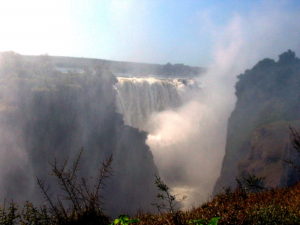
You see the smoke thirty miles before you see the falls, a plume rising above the dry bush country. The river is so powerful that the spray billowing up creates an entire ecosystem of lush, water-loving plants, ferns and mosses and dense, jungle-looking trees a hundred yards wide and a mile long across the front of the falls. In the parking lot on the Zimbabwe side, a lady will rent you a raincoat to keep your clothes dry and your camera from being ruined.
Inside the gate, you can look across and see the top of the falls eye-level on the Zambia side, or gape over the edge to the place your view disappears in the roiling mists below, and feel like you’re leaning over the rim of the world.
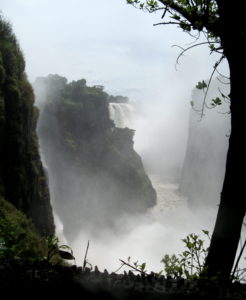
A rainbow arcs through the spray, thrown by the bright sun in an almost cloudless sky. The same rainbow, it occurs to you, that Livingstone saw when he came to this country.
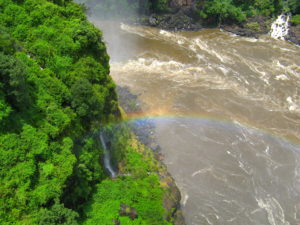
Dr Livingstone’s rainbow
The same rainbow Australopithecines gazed upon before modern humans were even thought of. On full-moon nights, there’s a moonbow.
Sometimes you can see people on the Zambia side, standing waist deep in the surging cascade right on the lip of the falls.
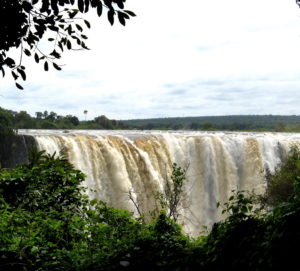
People wave at you from over there
Nothing but thundering water behind them, and for half a mile on either side, and rocks and mist and the end of the world below. On days when there’s somebody besides you on the Zimbabwe side, a little knot of tourists gathers, jaws open, pointing, wondering, “Who is that idiot?” and, “How could anybody be so stupid?”
“This is Africa, they tell one another with a shiver, feeling suddenly vulnerable and a little excited. Living on the edge, that’s why they’d made the trip. In Africa, you never know.
Whatever, it sure isn’t America. In the Land of the Free nothing like that would ever be allowed. In America there would be people with badges to keep fools from wandering out to the lip of the falls, and fences, and a huge hullabaloo if anybody actually went over.
The day before our first visit, a hippo went over. Now I don’t wish ill luck on any of god’s creatures, but I was sorry we missed that. Imagine, a hippo going over Victoria Falls. That would have been a sight to see.
The path along the Zimbabwe side should be thronged with people. Thousands of people. It’s designed for that, but almost nobody goes there. Sometimes there wouldn’t be anybody else at all, or just one other couple a mile away at the far end. Great for Peggy and me. It was like having our own, private UNESCO World Heritage site.
Still, it was sad. Victoria Falls may have been the only place left in Zimbabwe where people could earn hard cash. Robert Mugabe’s government had gotten such an evil reputation most people didn’t go anywhere near the place. Except, now that I think about it, bungee jumpers.
In 1905 the British threw an iron arch over the gorge downstream from the falls and, even, a century later, it’s hard to see how they did it.
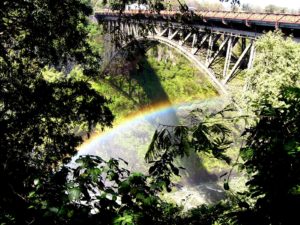
The bridge is one of those engineering feats that, a couple of thousand years from now some hack will make a fortune out of by claiming space aliens built. Right now, the money is in tying elastic ropes to people’s ankles and shoving them off.
A kid who got shoved told me that, when he was perched and ready to go, somebody asked whether he wanted the regular or the extreme version. What the hell, he thought, I’ve already paid. Might as well go for the extreme. Just as he was shoved somebody yelled, “My God. Tie the rope.”
A tough sergeant in the old South African apartheid army told us he’d strapped on the bungees and taken the plunge – three-hundred and some feet, his face almost grazing the rocks below. Didn’t think much about it until, a couple of nights later, he woke up screaming. He’d fought Cubans in Angola, chased terrorists through the bush all over Southern Africa, ventured into rioting townships outside Johannesburg, but going off that bridge was the only thing that ever gave him PTSD.
Something else you can do is buy a ticket to swim in the Devil’s Pool, which is a thing nobody back in British times ever accomplished. The Devil’s Pool wasn’t discovered until a drought in 2002 dropped the Zambezi so low that somebody besides a hippo was willing to walk out to the edge.
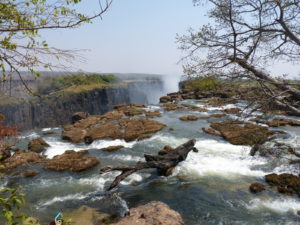
The Devil’s Pool is half-a-mile thattaway
The Devil’s Pool isn’t really a pool, it’s a person-wide cavity scooped out behind a six-inch slab of rock at the very edge of the falls. When the water is up, which, except for the summer of 2002 it’s been since the Pleistocene, it surges over rock and cavity both, and that part of Victoria Falls doesn’t look any different from any other part.
To get there, you wade across the Zambezi, then let the gentle current wash you down to the rock, or so they tell you when you buy the ticket. In practice, it’s more exhilarating. In the first place, where you wade across isn’t that far from the edge and you get the impression that, if you slip, they’re not going to need to give you your money back because you aren’t going to be around to ask. In the second place, “wading” doesn’t really describe the experience. What you do is leap into the current, swim like mad in the direction of a rock and hope you can grab on before you hippo into outer space.
After half a mile of this, you reach the launch site, a place twenty or thirty yards upstream from the Devil’s Pool. You can’t see the little scooped-out place. You can’t even see the slab of rock you’re supposed to wash up against because it’s hidden beneath roiling water that doesn’t look any different than the water going over the falls everywhere else, but the rock’s a good two feet wide, so how could you miss?
“Try to jump out a bit,” the guide announced when my turn came. “It’s shallow where we are and solid basalt underneath, and if you break something you won’t be able to grab the rock on the way by. On the other hand,” he gave a thoughtful look at the current, “don’t overdo the jump or you’ll miss the rock entirely.”
Then, for those of us who actually managed to wash up against the rock, we were in the mother of all infinity pools. We could lean over the edge, the whole force of the Zimbabwe crashing against our backs, and thundering past our elbows, and stare down at the end of the world disappearing in the mists below. Also, and this was the fun part, we could stand up and wave at the tourists on the Zimbabwe side while they pointed and said, “Who is that idiot?” And, “How could anybody be so stupid?”
When we were back on dry land something very African happened. They took us to a place beneath a thatched roof and fed us coffee and sweet rolls and eggs benedict with hollandaise sauce. That hollandaise sauce, after waving at people in Zimbabwe from the top of Victoria Falls, made a morning just about as sweet as a morning could get.
Not many people actually do this. Peggy wasn’t eager and our son had way too much common sense. “Pay to go to Devil’s Pool?” he said. “I’ll find it for myself,” and set out across the top of Victoria Falls and got there on his own.


No Comments